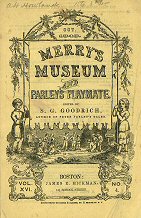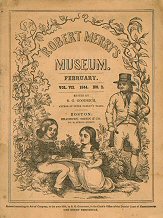Double Vision: Recycling Illustrations in 19th-Century American Magazines
[More examples]
Early periodicals often reprinted articles and poems that originally had appeared elsewhere: Fanny Fern’s success was assured when her first article was reprinted immediately in several other periodicals. Images were no exception.
The images on this page appeared in several venues. Cheap as wood engravings could be to produce, publishers made sure they got their money’s worth by reusing illustrations in various ways. Or pieces were written around illustrations already in the printer’s collection; Youth’s Magazine, of Cincinnati, Ohio, did this often late in its career.
http://www.merrycoz.org/double/DOUBLE02.xhtml
A triple play
This illustration was used in three different publications—by three different editors of Robert Merry’s Museum.
 Samuel Goodrich:
Robert Merry’s Museum cover for 1848
Samuel Goodrich:
Robert Merry’s Museum cover for 1848
Goodrich, founder of Merry’s Museum, was still its editor when this
cheery illustration of children at play was used on the cover. The design
didn’t last long;
it was replaced later that year by an
image emphasizing study.
 Stephen T. Allen: article in The Mother’s Magazine,
1851
Stephen T. Allen: article in The Mother’s Magazine,
1851
Allen took over as editor of Merry’s Museum in 1850. He also published the Mother’s Magazine. The center image of the 1848 Museum cover must have seemed a perfect accompaniment for his piece encouraging adults to enter into their children’s play; and it allowed for a tiny advertisement for the Museum! Amusingly, the banner-bearing children still appear in the image, with the boy’s staff a ghost and the girl’s foot still visible in the grass.
 John N. Stearns: “Merry’s Book of Puzzles,” 1856
John N. Stearns: “Merry’s Book of Puzzles,” 1856
Stearns edited the Museum when puzzles from its puzzle column were collected into a little paperback offered as a premium to those paying in advance. In this version of the image, the word “SCHOOL” has vanished—perhaps because the implication that the children are going to or from school wasn’t in keeping with the recreational nature of the book.
A change of identity
 Mark Forrester
Mark Forrester
"Robert Merry" apparently became “Mark Forrester” when the illustration was used 13 years later on the paper cover of
Forrester’s Juvenile Keepsake, a collection of pieces from the magazines that Forrester edited.
Mirror images
 (Simon) Peter the Little Gardener
(Simon) Peter the Little Gardener
W. N. Stevens, Variety Store, S. E. corner of Third and Arch Streets, Philadelphia.
This hand-colored wood cut advertised the W. N. Stevens Variety Store, at “S. E. corner of Third and Arch Streets,” in Philadelphia, Pennsylvania; the store was at this address from 1837 to 1839. (The store is advertised in Philadelphia newspapers until at least 1845.) Apparently created from the earlier illustration by someone unconcerned that it would print “backward,” its lines are much cruder. (And that hat still looks ready to fall off.) The engaging little illustration was one of a pair of advertisements owned by Simon P. Weidman, who put his name where it couldn’t be missed.
 The Harvest Girl
The Harvest Girl
W. N. Stevens, Variety Store, S. E. corner of Third and Arch Streets, Philadelphia.
Simon P. Weidman also owned this advertisement. Each advertisement measures about 6 inches tall and 5 inches wide.
[Other examples]




